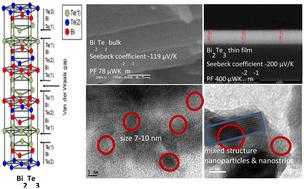Our official English website, www.x-mol.net, welcomes your
feedback! (Note: you will need to create a separate account there.)
纳米结构 Bi2Te3 热电材料的全面研究 – 来自同步辐射 XRD、XAFS 和 XRF 技术的见解
RSC Advances ( IF 3.9 ) Pub Date : 2024-01-08 , DOI: 10.1039/d3ra06731a
N G Imam 1, 2 , Shaimaa Elyamny 3 , Giuliana Aquilanti 2 , Simone Pollastri 2 , Lara Gigli 2 , Abd El-Hady B Kashyout 3
Affiliation

|
在这项研究中,结合使用基于同步辐射的技术(如 XAFS 和 XRF)以及其他一些实验室技术(如 XRD、XPS、FESEM 和 HRTEM),对纳米结构的 Bi2Te3 (BT) 热电材料进行了全面研究。本研究旨在跟踪 Bi2Te3 两个不同阶段的形态、组成、平均和局部/电子结构的变化;纳米结构(薄膜)和纳米粉末 (NP)。Bi2Te3 纳米材料采用一步法的区域熔化工艺制成颗粒,而 Bi2Te3 薄膜则使用真空热蒸发技术沉积在钠钙玻璃基板上。采用基于同步辐射的 Bi LIII 边缘荧光模式 X 射线吸收精细结构 (XAFS) 技术,局部探测 Bi 原子周围 BT 薄膜的电子和精细结构,同时透射模式 XAFS 用于分布在 PVP 基体中的 BT NPs。将收集的 BT 薄膜和粉末样品的 Bi LIII XANES 光谱的结构特征与使用 FDMNES 代码在 5 Å 簇大小下计算的 BT 模拟 XANES 光谱进行了比较。 将不同的离线结构表征技术(XRD、FESEM、XPS 和 HRTEM)与基于同步辐射的技术(XAFS 和 XRF)相结合,对于互补和支持的平均晶体、化学、形态和局部电子结构分析是必要的,以揭示 Bi2Te3 之间的差异在纳米结构/薄膜和纳米粉末形态中,然后在两种不同形态中连接 BT 的结构特征和功能。之后,我们测量了 BT 纳米粉末和薄膜的塞贝克系数和功率因数值。

"点击查看英文标题和摘要"







































 京公网安备 11010802027423号
京公网安备 11010802027423号